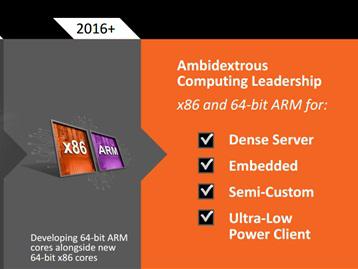Renowned semiconductor company Advanced Micro Devices (AMD +0.68%) is transitioning from PCs to high-growth markets. Last year, AMD gained a foothold in the semi-custom business and posted decent results in the last couple of quarters. The shift toward professional graphics and semi-custom seems to be paying off.
 Investor presentation Q2 2014
Investor presentation Q2 2014
The snapshot above depicts AMD's strategy. Growth markets include professional graphics, semi-custom (including gaming), mobility, and dense servers. Embedded systems are also a significant growth market, with a total addressable market of $9 billion, according to VDC Research. AMD has been leveraging its graphics technology to gain share in the professional graphics market, and it's betting on ARM to capitalize on the growth of dense servers. It recently announced a Puma core-based Mullins to seek growth in the tablet market.
However, like Intel (INTC 0.42%), the company had to overcome the ARM vs. x86 problem in order to grow in mobility and embedded systems. To counter this challenge, AMD revealed its product roadmap, which embraces ARM along with x86. This development puts the company in a position to grow regardless of whether ARM or x86 emerges as the winner going forward. ARM has been dominating the portable and low-power devices lately, and it is a sensible move on AMD's part to seek growth through ARM.
Ambidextrous roadmap
AMD recently announced a product roadmap that embraces ARM along with x86, something referred to as "ambidextrous." AMD licensed ARM's 64-bit architecture to build custom cores for high-growth markets. The company believes that the combined market for ARM and x86 is expected to grow to $85 billion by 2017. The roadmap also includes SkyBridge and the K12 custom core.
AMD is planning to release systems-on-chip and accelerated processing units based on both x86 and ARM in 2015. Both the SoCs will be pin-compatible, meaning that the same motherboard can be used to deploy either ARM or x86. This will result in flexibility and cost savings for original equipment manufacturers if they want to produce both the x86 and ARM variants. AMD may prove to be an attractive option for them in this regard. The products based on this structure will target embedded systems and certain client markets such as tablets, according to AMD's Lisa Su.
|
Process |
Cores |
Differentiating features | |
|---|---|---|---|
|
ARM |
20nm |
A57 |
HSA and GCN |
|
X86 |
20nm |
Puma+ |
HSA and GCN |
Extracted from company presentation

K12 core on the way
More promising than SkyBridge is the development of K12, a custom-designed high-performance ARM core that will leverage AMD's CPU, GPU, and design capabilities. It is expected to roll out in 2016. Jim Keller, a former CPU architect at Apple, says the K12 will share more than just pin compatibility. This could mean a combination of x86 and ARM on the same SoC. AMD recently added an ARM security processor in its Beema product line and seems to be quite capable of creating a hybrid ARM-x86 solution.
We have already seen that AMD has outperformed Intel's 22nm BayTrail with its Mullins and Beema using 28nm process. See "AMD's Superior Design Is a Game Changer". Now consider AMD's ARM cores on 14nm/16nm FinFET versus Intel's x86, and the outcome is quite clear. A custom-designed ARM SoC from AMD may be a critical success factor. In fact, it could be the deciding success factor for the company going forward.
Mobility fails and AMD
Critics may ask why AMD's custom SoCs will succeed in portable devices, while Intel and NVIDIA (NVDA 0.04%) have been unable to gain traction in the mobile space with their products. Here is why:
- The company has decided to utilize ARM, unlike Intel, and is leveraging its extensive GPU capabilities that others like Qualcomm do not possess. Adreno is currently widely adopted, but when we compare Adreno to NVIDIA's K series SoCs, it can be seen that NVIDIA's latest K1 -- Kepler architecture -- graphics capabilities are superior. It can be inferred that Radeon will at least match NVIDIA.
- NVIDIA outsmarts Qualcomm in graphics, but its CPU expertise is not as mature as that of AMD.
The point is that AMD has potentially identified a competitive sweet spot as it is overcoming the ARM problem by embracing it. It has more computing expertise than NVIDIA and is differentiated from Qualcomm in graphics. Moreover, it has a fallback position in x86 if its ARM efforts do not pan out.
Bottom line
|AMD might have been an underdog in the past, but its recent transition has placed it in a much better position than Intel to capitalize on high-growth business segments. Its recent design efficiencies in Puma cores, ARM licensing, and ARM custom cores have the potential to make it a very strong player that will leave its mark on the semiconductor industry in the next few years.
